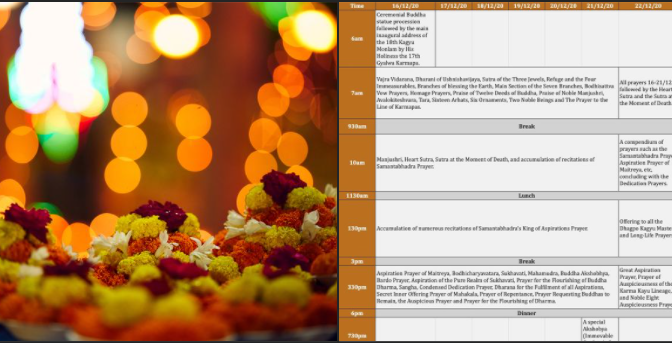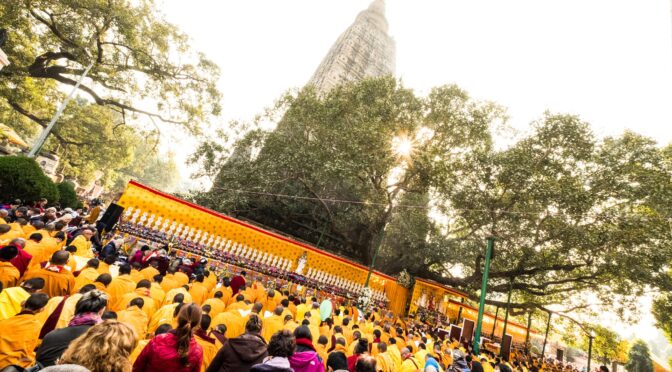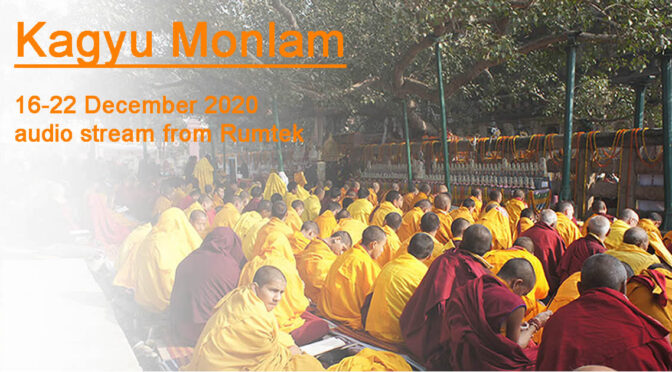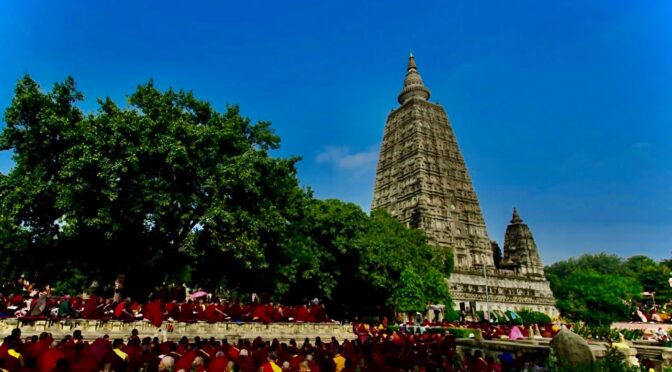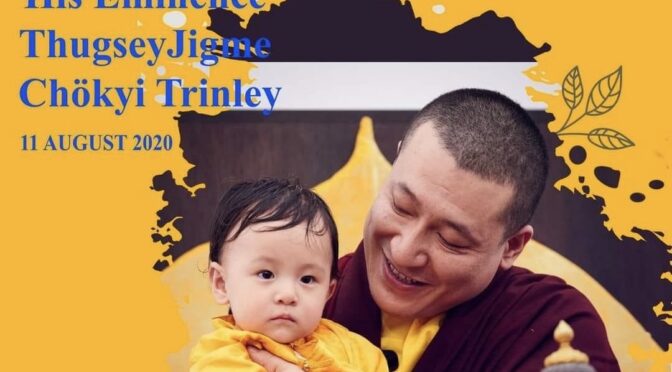- 妙境通訊2021 年 1 月& 2 月【學佛交流地帶】雞足山聖迹之求索與論辯 作者:賴成蔭
「中國佛教第一聖地」雲南雞足山乃傳説中佛陀大弟子大迦葉尊者護持佛陀衣鉢入定之地,一直等待彌勒佛的到臨,把衣鉢交付給祂。 雞足山腰峭壁華首門就是尊者入定處,很多朝聖者在此聽到誦經聲、或鈴聲豉聲之類。最著名的是虛雲和尚到此參拜時有洪亮的大鐘聲敲響!這個極神聖的地方卻較少朝聖者前往,究其原因有二:1. 鷄足山只列為中國佛教聖地的第五位,居於五台,峨嵋、普陀、九華之後,很多人(包括我) 在次序選擇上都會先去畢四大聖地才去雞足山的。 殊不知上述四大聖地乃「菩薩道場」而雞足山卻是今世文佛釋迦牟尼衣鉢所在,即是「薪火相傳」之地,理應為中國佛教第一聖地! 2. 很多人認為雞足山聖地是偽冒的,只不過是雲南佛教阿吒力派(又稱「滇密」)的自我吹捧之說,因為在印度佛經有清晰記載:雞足山是在王舍城附近的地區,於今尤在。 然而台灣的佛學大師南懷瑾則考証說:二千五百年前的雲南根本不屬中國,反而是屬於古印度王國極東北邊鄙之地,因此大迦葉尊者到此入定是有可能的! 若然雲南是佛教最早傳入中國之地!
「靈山一遇」 2019 年十月我夫妻倆參加了朝聖團飛往雲南,到逹昆明機場團友集合起來只得九人。其中一對年紀和我相近的姊妹,主動的對我説:我們好像在什麼地方見過面?我說自己是密乘修行者,但她們從來沒有出席過密宗的法會。於是大家笑著說:那就是我們曾在靈山一遇,彼此似曾相識! 原來兩姊妹去年已來過一次,今次是第二次到來朝聖。問其原因?她們說因為其師傅宏信法師兩年前由肇慶被邀請到雞足山迦葉殿任主持。她們還邀請大家待會拜畢華首門下山途中,
順道參觀迦葉殿。當天下午二時左右我們下山到達迦葉殿進內拜佛上香點燈。此時我卻忙著找妻子,但不知她進了那個殿參拜。我見到有一房間內有多人坐著交談,於是探頭進去看看。但見一位身穿袈裟的中年男子以很誠懇的語調請我進去喝茶。我進去坐下,便見到那兩姊妹,於是我知道這位出家人就是宏信法師了。我們並沒有對話,只是很友善的互望了一眼。那姊姊說:是了,後山有一塊大蓮花石,很有能量,你要去坐坐啊!法師說:對!對!你自己就去後山看看吧! 我見到他們正在交談,沒有人有給我帶路之意。雖然已很接近集合離開的時間,我仍決定獨個兒去後山找找看。說易不易,說難不難,我果然在後山的一個平台上,見到地面是一大塊呈蓮花狀的平滑石頭,上面可坐十多人的。一坐上去,就是充滿能量,非常舒服。但此時已過了集合時間,我只怱怱坐了不到十分鐘,便告別大石了。我跑回剛才的房間,想給法師供養,但房門竞己關閉無人。我急步到山門口集合處,赫然見到一名僧人正在拿著掃帚在掃樹葉,此人正是宏信法師!後來我才知道此石原來就是鼎鼎大名的「蓮花坐襌石」又名「入定石」,傳說中大迦葉尊者入雞足山修行弘法共五百年,才入定華首門,而很多時間他就是在這大石上禪定的!
「靈山二遇」 其實雞足山還有另一個朝聖者少有前往的原因,就是山高路險。此山海拔三千公尺,華首門在二千公尺的峭壁之上。以前朝聖者要由山腳上行三個多小時才可以到達。現在是我們先乘吊車到山頂(金頂),由此步行下山半個小時左右可到,然後再步行兩個小時到達山腳。當天下午一時左右,我們由金頂步行往華首門,途徑一個名叫「袈裟石」的小平台,是供人歇腳的。我夫妻兩人隨著大隊急步走經這裏,本來不應停下來的,但我想走近拍攝袈裟石,那是一大塊平面呈很多龜裂紋的石頭,傳說是大迦葉尊者曬袈裟之處。拍完照一回過頭來,竞然見到兩位相熟的噶舉派女尼!就是這一丁點的偶然,沒想到大家會在此相遇上!大家都說我們有緣靈山一會啊!期待著將來的二會、三會! 拍完合照道別之時,女尼在我耳邊說:記住必定要在華首門打坐,會有奇遇!於是我們在華首門禮拜之後,在岩壁前打坐了十五分鐘。聖迹有無中………….記得一次在新德里大寶法王佛學院聽 Lama Sherab Kalsang 開示,他極罕有地談到修行者若見到聖迹,其實這是體現了你的修行境界,乃至果位,因此這個不宜對任何人說的(除了你的上師和緊密的同修)。另外說這些很容易引起別人的「分別心」,那就不好了。
「著相」之辯終於我們一行人在回程的車子上,我忍不住問那兩姊妹:其實你們這麼快就再來雞足山朝拜,莫非在華首門見到了些什麼? 姊姊説:聴到唸誦聲,妹妹說見到大門打開。 此時我們的領隊(原來他是跟九華山的一位主持修禪宗的)忍不住開口說了金剛經的名句「若以色見我,以音聲求我,是人行邪道,不能見如來!」這個不但捧打朝聖者的死穴,更是敲打密乘修行者的要害!就是說你們執著於外物表狀形相,這根本就不是正道! 佛法就是「本來無一物」,大家究竟是來參禪禮佛,抑或是來尋找神跡奇遇的? 我就跟他糾正:「本來無一物」並非唐朝六祖壇經原句,原句是「佛性常清靜」(見於唐代敦煌寫經本)。佛性抑自性無論說是有或無,都是不正確的偏執。 我反問領隊「六祖壇經」中神會和尚見六祖,六祖打了他三棍,問他「痛不痛」?神會答「亦痛亦不痛」;就被六祖教訓了「痛就是痛、不痛就是不痛」。請問究竟神會被打是痛抑或是不痛呢?其實禪的真意就是如實觀照,被打當然是痛啦,但不要執著於痛便是了。修行者可以有喜怒哀樂,但不會執著於喜怒哀樂!見到了神迹就是見到了神迹,但不應執著於此,沾沾自喜,自以為了不起便是了。
「附論:大堪布卓德寧波車談雞足山真偽」 2019 年十二月我有幸在新德里大寶法王佛學院見到卓德寧波車,他是噶學派最有學問的其中一人,請教了他何處是真正雞足山聖地的問題:他說印度的雞足山他有到過,但不認為是真正的聖地。原因有二:1. 雖然地貌有些相似,但山太細小,太矮,不符合大山大嶺的記載。 2. 此山太近王舍城,不符合有關大迦葉尊者遠走偏鄙不毛之地的記載。雖然佛經有此記載,但他認為這個可能和「小迦葉尊者」的記載混淆所致。 他雖然沒有去過雲南雞足山,但認為這處應是真正的大迦葉尊者入定處。理由是:
1. 山形地貌及其地理距離和記載吻合。
2. 二千五百年前的雲南應屬古印度王國的範圍。
All posts by 妙境佛學會
2021年洽美仁波切給眾弟子的祝福及開示
2021年洽美仁波切給眾弟子的祝福及開示 :
親愛的香港法友們,
2020年對大家來説,是非常艱辛的一年。但從另一個角度去看,這一年讓我們更加體會到生命的可贵。
我們更應該珍惜這寶貴的人身,好好去深入了解佛法。疫情對于我們是一個非常大的障碍,但若我們懂得如何將障碍轉化為經驗,教訓及智慧,障碍则也能變得有利。
新的一年我充心希望各位對三寶更加有信心、虔敬心、以及保持良好三味耶。️大家新年快樂
️
On the first day of 2021, Chagmay Rimpoche has the following greetings for us:
Dear dharma brothers and sisters of Hong Kong:
The year 2020 has been a difficult year for all of us, yet if we look at it in a different aspect, it has definitely made us more awakened on the precious existence of ours, and how we should value it through the understanding of the Buddhas teaching.
The pandemic is a great obstacle but we if we can turn obstacle into a valuable lesson learned and through it gain wisdom, obstacle can be useful means as well. In this new year I wish all of you stronger Devotion, Respect and Samaya to the Three Jewels.
Happy New Year! ️
噶瑪巴 分享 有關尊貴的慈克秋林仁波切 於2020年12月18日在新加坡圓寂的消息
尊貴的慈克秋林仁波切 於2020年12月18日在新加坡圓寂的消息
第十七世大寶法王嘉華噶瑪巴泰耶多傑,分享有關尊貴的慈克秋林仁波切 於2020年12月18日在新加坡圓寂的消息。
尊貴的慈克秋林仁波切(Tsikey Chokling Ringpoche)於1953年誕生於西藏東部,是祖古烏金仁波切 (Tulku Urgyen Rinpoche)的二子,並被我的前任第十六世大寶法王噶瑪巴讓烱日佩 多傑(Rangjung Rigpe Dorje),認證為十九世紀大伏藏師秋吉德千林巴尊者 (Chokgyur Dechen Lingpa)第四次轉世。
慈克秋林仁波切(Tsikey Chokling Ringpoche)就讀於錫金隆德寺佛學院,在隆德寺裡他從我的前任第十六世大寶法王噶瑪巴讓烱日佩多傑(Rangjung Rigpe Dorje)得到了噶舉密咒藏、口訣藏和大手印。以及從頂果欽哲仁波切(Dilgo Khyentse Rinpoche)、敦珠仁波切(Dudjom Rinpoche)和祖古烏金仁波切(Tulku Urgyen Rinpoche)獲得完整寧瑪傳承的灌頂與口傳。
尊者住世時大部分時間都在尼泊爾最大的寺院之一,卡寧謝珠林度過,在寺院裡他擔任金剛上師。
慈克秋林仁波切(Tsikey Chokling Ringpoche)是一位成就卓越的學者和禪修大師,是秋林岩藏傳承持有者。
於2010年我在德里噶瑪巴國際佛學院領受尊者的秋林岩藏法,並與此加強了我們噶瑪噶舉與這偉大的大師在精神上的聯繫。
慈克秋林仁波切 (Tsikey Chokling Rinpoche)於2020年12月18日在新加坡示現這一生的圓寂。
我請所有學生為慈克秋林仁波切(Tsikey Chokling Rinpoche)的學生及所有眾生,祈請仁波切早日乘願歸來。
同時,為了尊崇慈克秋林仁波切(Tsikey Chokling Rinpoche)的遺志,願我們全心全意地投入於佛法的修行。
致上祈禱
第十七世大寶法王嘉華噶瑪巴泰耶多傑
Thaye Dorje, His Holiness the 17th Gyalwa Karmapa, shares a message regarding the passing of His Eminence Tsikey Chokling Rinpoche on 18 December 2020 in Singapore.
‘His Eminence Tsikey Chokling Rinpoche was born in eastern Tibet in 1953 as the second son of Tulku Urgyen Rinpoche, and recognised by my predecessor, Rangjung Rigpe Dorje, His Holiness the 16th Karmapa, as the fourth reincarnation of the great 19th-century terton (treasure revealer) Chokgyur Dechen Lingpa.
Tsikey Chokling Rinpoche studied at Rumtek Monastery in Sikkim, where he received the transmissions of the Kagyu Ngag Dzo, Damngag Dzo and Mahamudra from my predecessor Rangjung Rigpe Dorje, as well as the transmissions of the entire Nyingma lineage from Dilgo Khyentse Rinpoche, Dudjom Rinpoche and Tulku Urgyen Rinpoche.
His Eminence spent most of the rest of his life at Ka-Nying Shedrup Ling, one of the largest monasteries in Nepal, where he served as Vajra Master.
An accomplished scholar and meditation master, Tsikey Chokling Rinpoche was a holder of the Chokling Tersar lineage of teachings.
Our Karma Kagyu school’s profound spiritual connection with this great master was further strengthened when I received the transmission of Chokling Tersar teachings from him in 2010 at the Karmapa International Buddhist Institute in Delhi.
Tsikey Chokling Rinpoche manifested the parinirvana in this life-time on the 18th of December, 2020, in Singapore.
I ask all of my students to pray for Tsikey Chokling Rinpoche’s swift rebirth, for the sake of his students and all beings.
In the meantime, may we all honour Tsikey Chokling Rinpoche’s legacy by devoting ourselves to the practice of the Buddha dharma with one-pointed focus.
With prayers
Thaye Dorje, His Holiness the 17th Gyalwa Karmapa’
Source: https://www.karmapa.org/karmapas-message-regarding-the-passing-of-his-eminence-tsikey-chokling-rinpoche
#Karmapa
(中文翻譯由本中心翻譯小組負責。若有錯漏,請見諒。節錄或載列文章內容以原文為準。)
2020年噶舉祈願法會時間表與現場直播
2020年噶舉祈願法會時間表與現場直播。
噶舉祈願法會將於2020年12月16-22日舉行。
我們在菩提伽耶的年度法會因疫情持續而延期,祈願法會將安全地在印度與尼泊爾各寺院中舉行,為數約千名的僧尼會參與此次法會。
誠意邀請您們一起參與在隆德寺舉行的網上直播祈願法會,其中還有第十七世大寶法王嘉華噶瑪巴泰耶多傑的歡迎致辭。
正如噶瑪巴在邀請大家參與網上直播所說的, 「我感到我們很幸運,現有科技使我們能夠一起修習,我將與來自世界各地的你們一起參加祈願法會。」
如何收看直播? 您可以在噶瑪巴的Facebook頁面或在噶瑪巴官方網站收看現場直播:https://www.karmapa.org/live-stream-kagyu-monlam-2020/
現場直播何時進行? 如圖附上第18屆噶舉祈願法會直播時間表(上述時間均為印度當地時間,並可能因應調動作出更改。)
Kagyu Monlam 2020 schedule and live stream.
The Kagyu Monlam takes place from 16–22 December 2020.
Following the postponement of our annual gathering at Bodh Gaya due to the ongoing pandemic, Monlams will be safely held in various monasteries across India and Nepal, by about a thousand monks and nuns.
You are invited to join a live audio stream of the Monlam being held in Rumtek, which will also include a welcome address by Thaye Dorje, His Holiness the 17th Gyalwa Karmapa.
As Karmapa says in his invitation to join the live stream,
‘I feel that we are very fortunate to have the necessary technology to allow us to practice together, and I will be joining the aspiration prayers along with all of you around the world.’
How can I listen to the live stream?
You can listen to the live stream on Karmapa’s Facebook page, or on Karmapa’s official website here: https://www.karmapa.org/live-stream-kagyu-monlam-2020/
When is the live stream?
The live stream schedule for the 18th Kagyu Monlam is shown in the image (all times are in local Indian time and subject to change).
#Karmapa
(Source: https://www.karmapa.org/kagyu-monlam-2020-schedule-and-live-stream/)
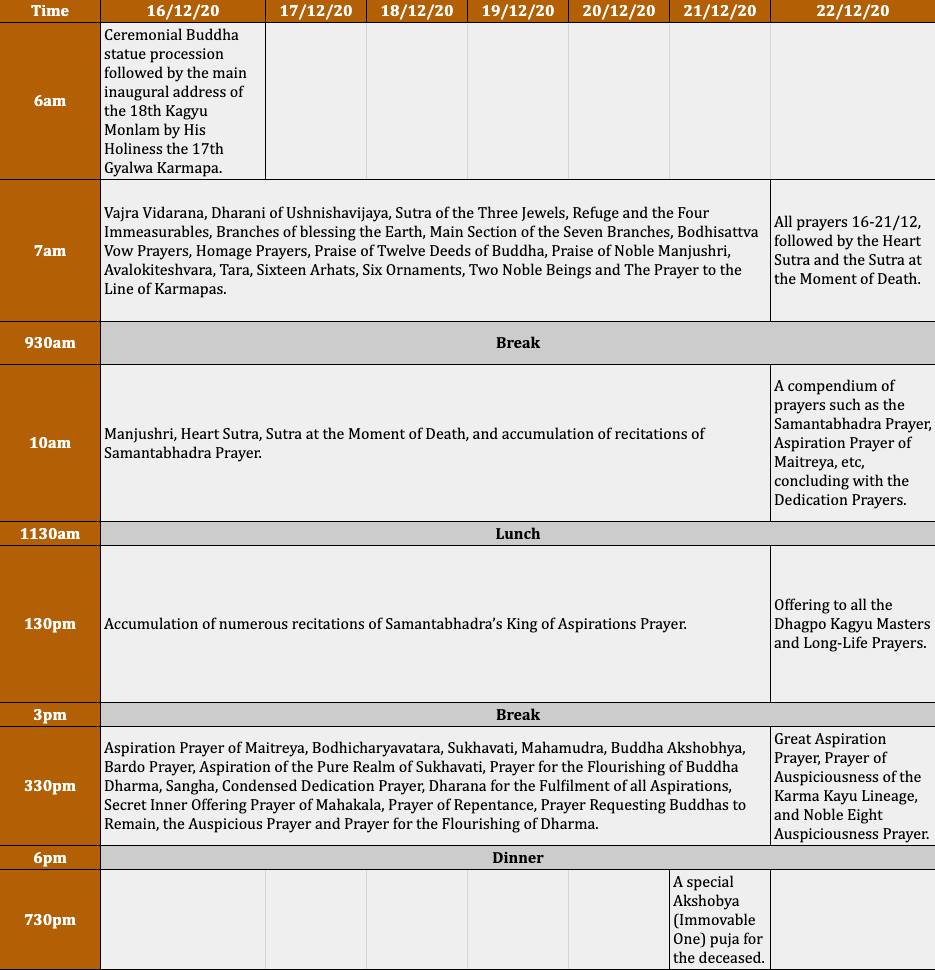
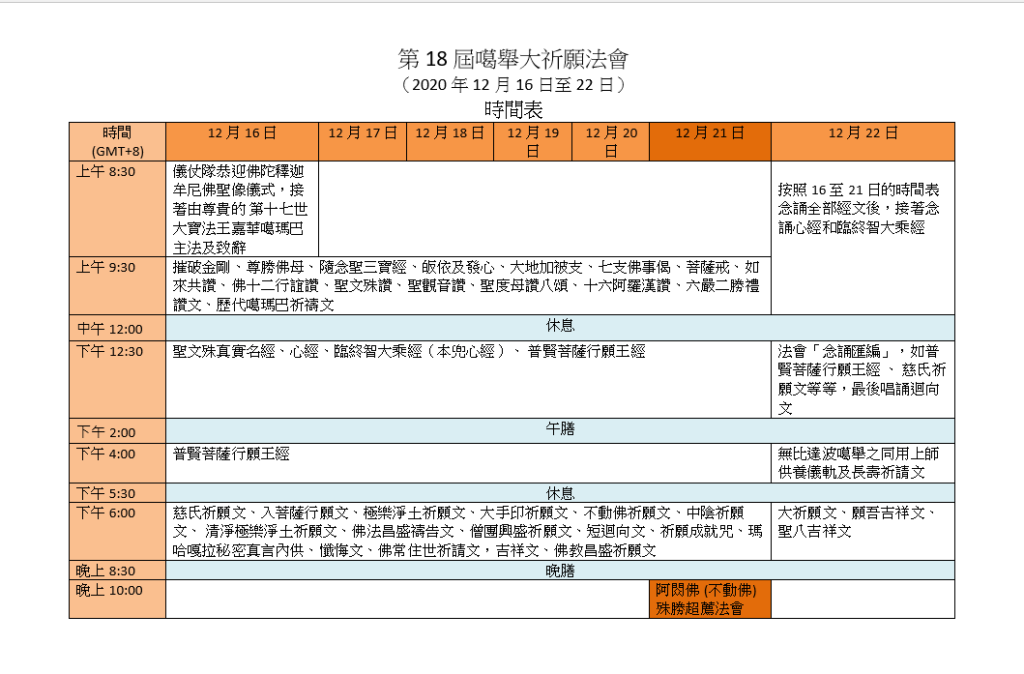
(中文翻譯由本中心翻譯小組負責。若有錯漏,請見諒。節錄或載列文章內容以原文為準。)
噶瑪巴私人辦公室於2020年噶舉祈願法會之前分享以下信息
噶瑪巴私人辦公室於2020年噶舉祈願法會之前分享以下信息:
在我們噶瑪噶舉派歷史上,第三世噶瑪巴讓烱多傑 (Rangjung Dorje的)(1284-1339)發起了一年一度祈願法會。 其後,在第七世噶瑪巴確札嘉措(1454-1506)期間,法會成為西藏最著名的佛教盛事之一。
於我們這個時代,1994年由已故第十四世昆津夏瑪仁波切發起噶舉祈願法會,今年將是第十八屆。第一次及往後的祈願法會都是在藍毗尼舉辦,直至1996年起法會於菩提迦耶舉行。
來自世界各地的尊貴僧眾與在家修行人於法會中聚首一堂,為所有眾生的遠近利益和安樂,作無量無邊的祈願、祈禱與回向。 迄今為止,這個為期七天於十二月在印度的菩提迦耶舉辦的傳統,是在一棵非常殊勝的菩提樹下進行,一千零二尊佛為利益一切有情故,在此非常殊勝的菩提樹下證得無上正等正覺。 每次的盛會聚集來自世界各地成千上萬的僧尼、在家修行者和信徒在菩提迦耶進行祈願法會。 但是,由於Covid-19造成了前所未有的疫情,今年的祈願法會將在環境安全的印度和尼泊爾寺廟中進行,而不是僧俗二眾聚集於菩提迦耶。
參加2020祈願法會的每間寺廟,僧尼人數均符合當地COVID條例和法規。
今年,在印度和尼泊爾舉行的噶舉祈願法會是由第十七世大寶法王嘉華噶瑪巴泰耶多傑私人贊助。 與大寶法王共同贊助印度噶舉祈願法會和尼泊爾噶舉祈願法會,分別由Katherine Cheng夫人和Ibu Dewi Kam夫人。
我們衷心感謝Katherine Cheng 夫人和 Ibu Dewi Kam夫人共同贊助今年噶舉祈願法會,使我們能夠在寺廟和佛學院的安全環境中,延續這一年一度的傳統,也因此能將法會直播到我們家中。她們的慷慨解囊使我們尊貴的僧伽可以全心全意專注於祈願和回向。
以下是舉行噶舉祈願法會的印度寺廟和佛學院:
Karmapa International Buddhist Society, New DelhiKarmae Sangha Rumtek Monastery, RumtekNedo Chedu Choekhorling Monastery, RumtekKarma Chokhor Dechen Ling Nunnery, RumtekKarma Tarjay Chokhorling Monastery, BodhgayaRey Mindu Tempen Ka-ten Namgyal Ling Monastery, SikkimKarma Dupgyud Choeling Monastery, LadakhKarma Chagchen Jampaling Nunnery, LadakhDiwakar Buddhist Academy, KalimpongDiwakar Buddhist School, TakdahTilopa Buddhist Institute, Tilokpur
以下是舉行噶舉祈願法會的尼泊爾寺廟和佛學院:
Ka-Nying Shedrub Ling Monastery, KathmanduDhagpo Sheydrub Ling Monastery, NalaKarma Ngedhon Osal Choekhorling, KathmanduSangye Choeling Monastery, KathmanduBuddhist Nunnery School, KathmanduSharminub Institute, KathmanduDhuldarling, KathmanduKarma Raj Mahavihara, KathmanduLhundrup Choling Monastery, KathmanduTrungram Gumba (Dhakten Nyincheling), KathmanduTrungram Nunnery, KathmanduKarma Dubgyu Chokorling, PokharaMila Kagyu Ling Mahaboudha Gumba, NawalpurKarma Theksum Choiling Monastery, PokharaJangchub Choeling Monastery, PokharaKagyu Institute for Buddhist Studies, Kirtipur, KathmanduTharpa Choeling Nunnery, Muktinath, Mustang
噶瑪巴云
「願這個殊勝的日子為我們個人和大眾種下與增長善根。願播下與長養和平與智慧的種子,藉由相互依存的世間現象,對無論是流行病、戰爭、飢荒或自然災害等等的外在環境都能帶來正面影響。
願我們的祈願能有助保存及護持2500多年前釋迦牟尼佛弘揚的原始佛法。願我們能確切認識並讚嘆佛法對宇宙萬事萬物的契合與潤澤。」
The Private Office of the Karmapa shares the following message in advance of the 2020 Kagyu Monlam:
In our Karma Kagyu School, it was historically the third Karmapa Rangjung Dorje (1284-1339) who initiated the yearly Monlam gathering.
Later, during the time of the seventh Karmapa Chodrag Gyamtso (1454-1506), it became one of the most prominent Buddhist gatherings in Tibet.
This year’s Kagyu Monlam will be the 18th gathering since its initiation in our time by the late His Holiness 14th Kunzig Shamar Rinpoche in 1994. The first of these Monlams was held at Lumbini, and all the following ones, from 1996 onwards, in Bodhgaya.
During these occasions, the venerable monastic Sanghas and lay practitioners from around the world gather to conduct limitless aspirations, prayers and dedications for the immediate and far reaching benefits and wellbeing of all sentient beings.
To date, this practice has been held during the month of December for seven days in Bodhgaya, India, under the very Bodhi tree where all 1002 Buddhas of this Fortunate Aeon complete their awakening for the benefit of all sentient beings.
During each of these occasions, thousands of monks, nuns, lay practitioners and devotees from around the world came together in Bodhgaya to conduct these Monlam prayers.
However, this year – due to the unprecedented pandemic caused by Covid-19 – instead of assembling the venerable Sanghas, lay practitioners and devotees at Bodhgaya, the Monlam prayers will be conducted in the safe environments of the monasteries in India and Nepal.
The number of monks and nuns performing and participating in each monastery for Monlam Prayers 2020 are in accordance with local COVID rules and regulations.
This year, the Kagyu Monlam prayers in India and Nepal are personally sponsored by Thaye Dorje, His Holiness the 17th Gyalwa Karmapa.
For India, the Kagyu Monlam is co-sponsored by Mrs. Katherine Cheng and for Nepal the Kagyu Monlam is co-sponsored by Mrs. Ibu Dewi Kam.
With heartfelt appreciation, we are deeply grateful to Mrs. Katherine Cheng and Mrs. Ibu Dewi Kam for co-sponsoring this year’s Kagyu Monlam, thus helping to uphold the continuum of this yearly event in the safe environment of our monasteries and institutes and through live streaming to our homes. Their generous sponsorship makes it possible for our Venerable Sanghas to wholeheartedly conduct these practices without interruption and focus solely on the practice of these aspirations and dedications.
The monasteries and institutes holding Kagyu Monlams in India:
Karmapa International Buddhist Society, New DelhiKarmae Sangha Rumtek Monastery, RumtekNedo Chedu Choekhorling Monastery, RumtekKarma Chokhor Dechen Ling Nunnery, RumtekKarma Tarjay Chokhorling Monastery, BodhgayaRey Mindu Tempen Ka-ten Namgyal Ling Monastery, SikkimKarma Dupgyud Choeling Monastery, LadakhKarma Chagchen Jampaling Nunnery, LadakhDiwakar Buddhist Academy, KalimpongDiwakar Buddhist School, TakdahTilopa Buddhist Institute, Tilokpur
The monasteries and institutes holding Kagyu Monlams in Nepal:
Ka-Nying Shedrub Ling Monastery, KathmanduDhagpo Sheydrub Ling Monastery, NalaKarma Ngedhon Osal Choekhorling, KathmanduSangye Choeling Monastery, KathmanduBuddhist Nunnery School, KathmanduSharminub Institute, KathmanduDhuldarling, KathmanduKarma Raj Mahavihara, KathmanduLhundrup Choling Monastery, KathmanduTrungram Gumba (Dhakten Nyincheling), KathmanduTrungram Nunnery, KathmanduKarma Dubgyu Chokorling, PokharaMila Kagyu Ling Mahaboudha Gumba, NawalpurKarma Theksum Choiling Monastery, PokharaJangchub Choeling Monastery, PokharaKagyu Institute for Buddhist Studies, Kirtipur, KathmanduTharpa Choeling Nunnery, Muktinath, Mustang
Karmapa says,
‘May this auspicious occasion create and strengthen the root and expression of merit and virtue for our personal and collective wellbeing. May seeds of harmony and wisdom be sown and nurtured, which in turn through the interdependency of all apparent phenomena will have a positive influence on outer circumstances, be it epidemics, war, famines or natural disasters.
May our aspirations help to preserve and strengthen the Dharma, which was conveyed by Buddha Shakyamuni more than 2500 years ago. May we recognise and appreciate its universal applicability and goodness in all areas of existence.’
(Photos: Thule / Tokpa Korlo / Norbu Zangpo)
#Karmapa
(Source: https://www.karmapa.org/message-in-advance-of-the-2020-kagyu-monlam/)
(中文翻譯由本中心翻譯小組負責。若有錯漏,請見諒。節錄或載列文章內容以原文為準。)
噶瑪巴邀請學生一起參與噶舉祈願法會現場直播
噶瑪巴邀請學生一起參與噶舉祈願法會現場直播
第十八屆噶舉大祈願法會2020
依照大寶法王嘉華噶瑪巴的指示,噶舉大祈願法會委員會正籌備2020年度噶舉大祈願法會,一連七天的法會將於2020年12月16日至12月22日在各大社交媒體平台直播。
大祈願法會將會由隆德寺僧伽為首及帶領,我們非常歡迎來自世界各地的你們一起參加這祈願法會。
世界和平唱誦噶舉大祈願法會2020聲頻直播串流連結
Kagyu Monlam 2020 streaming link:
www.facebook.com/KagyuMonlamChenmo/live
Kagyu Monlam Prayer books download:
www.kagyumonlamchenmo.org/prayer-book
The 18th Grand Kagyu Monlam Chenmo 2020
On the instruction of His Holiness the Gyalwa Karmapa, the Kagyu Monlam Committee will organize the 2020 Kagyu Monlam to commence from 16/12/20 to 22/12/20 for a week on various social media platforms.
The Monlam will be conducted and led by the monastic sangha of Karmae Sangha Duche – the main seat of his Holiness in Rumtek and we welcome all to participate in the collective aspiration and observances.
World Peace Chanting Kagyu Monlam Chenmo 2020 Audio Live Streaming Link
Kagyu Monlam 2020 streaming link:
www.facebook.com/KagyuMonlamChenmo/live
Kagyu Monlam Prayer books download:
www.kagyumonlamchenmo.org/prayer-book
(中文翻譯由本中心翻譯小組負責。若有錯漏,請見諒。節錄或載列文章內容以原文為準。)

第十七世大寶法王嘉華噶瑪巴 分享有關 今年12月16至22號 舉辦噶舉祈願法會 的訊息
噶瑪巴邀請學生一起參與噶舉祈願法會現場直播
November 23, 2020
第十七世大寶法王嘉華噶瑪巴分享有關今年12月16至22號舉辦噶舉祈願法會的訊息。
親愛的法友
我誠意邀請各位透過在隆德寺的現場直播,參加今年噶舉祈願法會。
令人遺憾的是,由於COVID-19疫情,迄今為止已有近5900萬人確診,超過130萬人和上百萬動物失去生命,我們今年無法舉行面對面式的法會。
不過,我感到我們很幸運,現有科技使我們能夠一起修習,我將與來自世界各地的你們一起參加祈願法會。
我想藉此機會與你們分享我對佛法的一些看法,尤其是祈願的修持。
當然這個每年一次以隆德寺僧伽為首,帶領我們念誦祈願文的法會是一個歷史悠久的傳統。
但是,如果我們真的對此活動深思並問自己目的是什麼,奇怪的是很難找到一個明確的答案。
作為人類,我們主要受到一種觀念來驅使我們做任何事情。這種觀念就是無論我們做什麼,都必須有一個目的,否則就毫無意義。儘管該理論有它的原因,但如果我們僅依靠這種邏輯,那麼對於我們來說找到一個很好的理由來持續像噶舉祈願法會這樣的一個傳統,是一種挑戰。
但是,我感到我們需要為此傳統感恩。
為什麼?
人類社會的運作模式使我們感到必須從事情中獲得一切,連最簡單的事情也需如此,即使我們從繁忙的日常工作中抽出五分鐘,我們也會感到內疚,除非我們認為自己獲得了可以享受這五分鐘的權利。
雖然佛教徒認為這種思維方式與事物本身和現實的本質並不一致,但是從佛教徒的角度來看,如果我們也是由這種必須獲得結果的理論,驅使我們做任何事情的話,那麼為了體驗我們相信的東西是不是真的,一直走下去就變得有其意義。
因此,從這個意義來說,任何的佛法修持就像是一種工具,使我們能夠完全按照自己相信的往前進。
這樣子,修行可以使我們的道路變得更完整。
如果我們從一開始就了解這一點,我們就不會被成功的想法所限制。在祈願時,我們不會從錯誤的觀念開始,以為我們必須要成功,因為成功的想法總是與失敗的想法密切聯繫在一起的。
因此,祈願的修持是一條使我們能夠探索自己的信念,而沒有任何承諾或保證結果的途徑,就像是「親自看一看,你相信的是不是就是這樣。」
換句話說,如果我們堅信我們需擔任佛教徒的角色,並且希望一直堅持下去,那麼我們就有很好的機會,今年連續7天,從12月16到22日,我們能夠將這角色完美的發揮。
因此,如果你想祈願,這裡是一個將祈願達到極致的平台!
利用此平台來探索你真正相信的東西,並充分享受它,不要期望成功或恐懼失敗。
全心全意地享受它。
我邀請大家與我們一起參加這次法會,讓我們以佛教徒的身份,沒有任何障礙。我們有唱誦師領唱,我們有導師來指導法會,可以這麼說,我們有樂器可以使你在適當的氛圍,我們有歌曲和旋律來表達我們的祈願。
讓我們聚到一起,並利用這種自由為所有眾生,尤其是那些受到疫情嚴重影響的眾生祈禱!
無需保持社交距離,也無需遮住嘴巴,只需透過電子屏幕和電子音響,我們便可以完美地發揮佛徒的身分,不用感覺我們正在執行某種使命。
但是,不要有是我要求或命令你們參加修持這樣的一個概念,令自己感到一種負擔。不要因為我們是佛教徒,就認為有義務去做或是不應該去做。
但是,如果你希望能親證自己遵循的信念會發生什麼事情,做得徹底且精進修行是合乎邏輯的唯一做法。
同時,你無需感到有任何負擔,因為祈願修持不需要像密勒日巴尊者這樣建九層大樓,也不需要像那諾巴尊者忍受十二大苦行與十二小苦行,也不用像悉達多太子多年修習苦行。
相反,你可以在舒適的家中探索祈願所帶來的潛能,這樣我們還能要求什麼?
因此,親愛的法友,請你們毫無疑問或猶豫,全心全意地享受,為一切有情而祈願!
Karmapa invites students to Kagyu Monlam audio stream
November 23, 2020
Thaye Dorje, His Holiness the 17th Gyalwa Karmapa, shares the following message regarding this year’s Kagyu Monlam, which takes place from 16-22 December.
Dear dharma friends
I would like to invite all of you to join this year’s Kagyu Monlam prayers via live audio stream from Rumtek.
It is regrettable that, due to the COVID-19 pandemic, with nearly 59 million cases, more than 1.3 million human lives and millions of animal lives lost so far, we will not be able to come together in person this year.
Nevertheless, I feel that we are very fortunate to have the necessary technology to allow us to practice together, and I will be joining the aspiration prayers along with all of you around the world.
I would like to take this opportunity to share some of my own thoughts with you, concerning Buddhist practice in general, and in particular the practice of aspirations.
Of course, we have this long-standing tradition of gathering once a year for the recitation of aspiration prayers, led by our monastic sangha from Rumtek.
But if we really investigate this activity and ask ourselves what the purpose is, curiously enough, it will be difficult to come up with a solid one.
As human beings, we are driven primarily by the concept that no matter what we do, there has to be a purpose – otherwise it is pointless. And while that theory has its own place, if we rely exclusively on that logic it might be challenging for us to find a good reason why we should keep up traditions such as the Kagyu Monlam.
Yet, I feel that we need to be thankful for this tradition.
Why?
Our human society functions in a way in which we feel that we have to earn everything, down to the simplest of things: even if we just take five minutes break out of our busy daily schedule, we feel guilty unless we think that we have somehow earned the right to enjoy it.
While Buddhism understands that this way of thinking is not really in line with the way things are, with the nature of reality – nevertheless, from a Buddhist point of view, if we are driven by the theory that every result must be earned, then it makes sense to go through with it all the way, in order to experience for ourselves whether what we believe is true or not.
So in that sense any Buddhist practice is like a vehicle to allow us to go all the way, fully, with what we believe.
In that way, the practice will complement what we think the path is.
If we understand this from the beginning, then we will not be driven by the idea of success; in the case of aspirations, we will not start out with the mistaken belief that we have to have a ‘successful’ aspiration, because this very idea of success invariably goes hand in hand with the idea of failure.
So the practice of aspiration is a path that allows us to explore our beliefs all the way, without any promise or guarantee for a result, like saying, “See for yourself whether what you believe is it – or not.”
In other words, if we hold the belief that we need to play the role of being a Buddhist, and we want to go all the way with it, then we have the perfect opportunity: this year, for seven days – from 16 to 22 December – we will be able to play that role to perfection.
So, if you wish to aspire, here is a platform to aspire to the fullest!
Use this platform to explore what you truly believe – enjoy it to the fullest, without any expectation of success or fear of failure.
Enjoy it wholeheartedly, with full freedom.
I invite all of you to join us – let us play at being Buddhist, without any hang-ups. We have the Umdzes to lead the chants; we have our disciplinary masters to direct and guide the performance; we have the musical instruments to put you in the right mood, so to speak; we have the songs and the melody to voice our aspirations as one.
So let us come together and use this freedom to pray for all sentient beings, and especially all those whose lives have been severely affected by the pandemic!
Without having to practice social distancing, without having to cover our mouths, through a digital screen and a digital sound box, we can play our Buddhist role to perfection, without feeling that we are on some kind of mission.
However, do not burden yourself with the notion that this is a request or a command from me to join this practice. There is no obligation for us to do this or not do this because we are Buddhists.
But should you wish to see for yourselves what happens if you follow your belief all the way, then it is only logical for you to be thorough and diligent all the way.
At the same time, there is no need for you to feel any sense of burden, because this particular practice of aspiration doesn’t require you to build any nine-storey towers like Milarepa, nor does it demand of you to endure the twelve minor and twelve major hardships of Naropa, nor to undergo years of gruelling ascetic practice like Prince Siddharta.
Instead, you can explore the full potential of aspirations from the comfort of your own home. What more could we ask for?
Therefore, dear dharma friends, aspire for all sentient beings, without doubt or hesitation, but with whole-hearted enjoyment!
Source:
Karmapa invites students to Kagyu Monlam audio stream
#Karmapa #Kagyu #Monlam
(中文翻譯由本中心翻譯小組負責。若有錯漏,請見諒。節錄或載列文章內容以原文為準。)
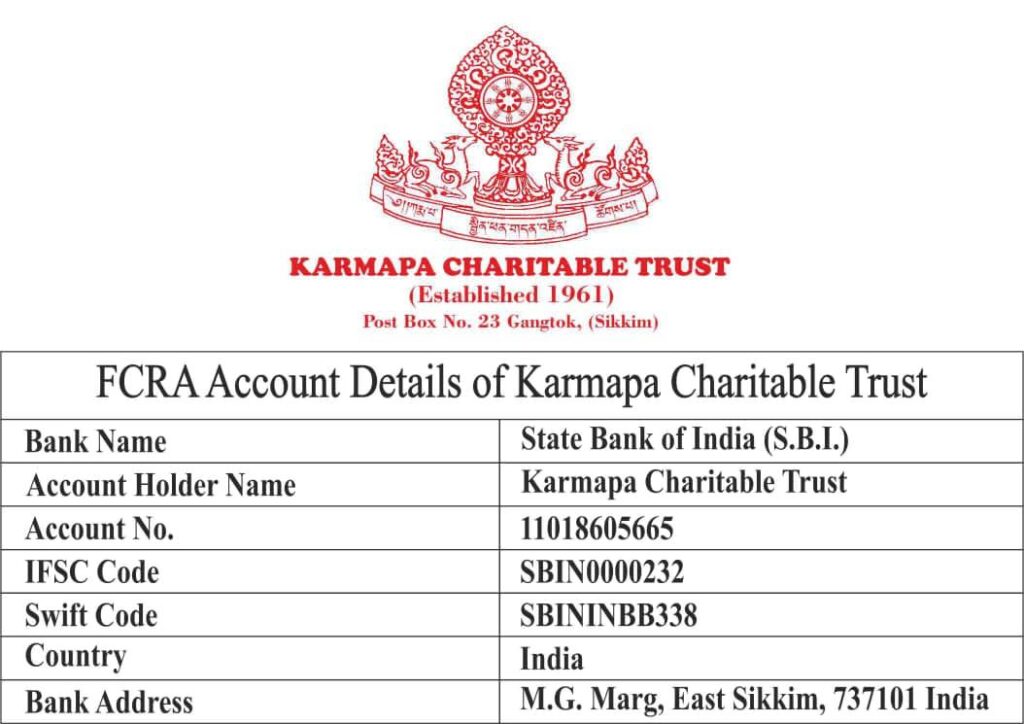
在噶舉祈願法會期間,歡迎善信隨緣樂助:
1)酥油茶:每份3000盧比(港幣 315.3)
2)茶點:每份7000盧比
(港幣 735.7)
3)供酥油燈:每份108盞
1500 盧比(港幣157.7)
4)供僧:每份供100人
25000 盧比 (港幣2627.5)
5)中午供僧膳食:每份50000盧比 (港幣5255)
6)全日供僧膳食:每份100000盧比 (港幣10510)
1 盧比 = 0.1051 港元(今日對換價)。以上只是參考價。
法會贊助:隨喜
聯絡方式如下:
Whatsap : +91-8617658907
電郵:thekagyumonlamchenmo@gmail.com
截止日期:12月14日
大寶法王的西藏回憶
- 妙境通訊2020 年 11 月 & 12月【學佛交流地帶】
題目:大寶法王的西藏回憶 作者: 賴成蔭 西藏拉薩市中心小昭寺旁的八廓街,就是大寶法王童年居住之所,他從出生到離開西藏之前,都是和家人住在那兒。這個房子現在還可以找到嗎?大寶法王說這個房子其實很容易找,因為整條八廓街的房子,每幢之間都有一個闊約一尺的空間距離,唯獨是他的房子和鄰屋是偎貼在一起,而且還是頂部相互緊靠支撐著的。 我們趁到西藏拉薩朝聖的機會,在八廓街上走了兩轉,就是找不到!吃晚飯時和羊八井的喇嘛談起,他說可以帶我們去看看,然而因為天色太晚,不大方便,終於沒有去。我又記起法王曾說: 八廓街在他離開西藏後全部拆卸重建,估計這房子已不存在了。就我所見八廓街上的房子並不很舊,不可能是舊居所在之地。猛然想起大寶法王最後輕描淡寫地說: 其實這樣樓房相互緊貼著不倒塌是個奇蹟!正因如此,法王的父親「米龐寧波車」極受當地人的尊敬,每天有不少人上門禮拜供養。寫到這裏,我又深覺大寶法王實在太謙虛了!
小昭寺就在法王住處不遠,收藏著唐朝尼泊爾金城公主由印度帶來的佛陀八歲等身像。法王其時年紀很少,但已為之著迷。因著舅父和小昭寺管門喇嘛相熟,每天大清早趁仍未對外開放的時段,法王便走到了這尊佛像的面前。他發現佛像的膝部有一個大洞(估計是在文化大革命時被破壞的)他就是喜歡坐在這個孔洞上,一本正經的想像自己在修練一段時間。 大寶法王曾指出這座八歲等身佛像的面相和當今在印度菩提伽耶大塔寺殿內的佛陀像完全一樣。我認為那是世上最美的佛像。所謂「等身」就是真人大小的尺寸。至於為何八歲的佛陀面相和身軀已是一個成熟的美少年?這可能是佛陀身體的成長速度比一般人快得多吧!(也許釋迦族人的身軀比較高大,發育成長也較早) 但就現在所見小昭寺佛像的面相圓潤飽滿,完全不似菩提伽耶那尊。我相信是在大寶法王童年時候,小昭寺的佛像臉龐並没有經歷數以千計朝聖信眾以金萡鋪面粉飾,面相遠為清瘦,而被法王看出和菩提伽耶的佛像面相完全相同。 法王坐在佛像膝上時模仿着喇嘛做冥想,究竟他在想什麼呢? 有一次法王告訴我,他的弟弟非常頑皮,經常把他心愛的玩具砸爛。在那個物資缺乏的年代,這個是何等令人心碎的事情啊!法王就坐在佛像膝上,幻想著自已會法術把玩具復原。奇蹟發生了,他居然能夠做得到! - 這個很可能是法王第一次發現自已是超級魔術師,擁有一雙具有神力的手。久之,他的弟弟也知道了這個秘密,不斷拿損壞了的玩具,央求他幫忙。我相信就在這個時候大寶法王便已知道自已具有神秘的過人本領,此所以他在剛離開西藏到達印度新德里 KIBI 寺院居住,當 Lama Sultrim 挑戰他究竟是否真正的大寶法王時,他就滿有信心的叫 Lama Sultrim 拿出那柄粗硬而短小的精鋼刀子來,毫不猶豫的用兩隻小指頭剎那間便把刀子撓彎到近乎對摺的 U 型狀態! 這是一個很有名的神跡, Lama Sultrim 很樂意把這柄 U 型小刀給虔誠的信眾展示。 傳說中嘉察寧波車在某天绝早趁無人時段參觀了小昭寺,就在走到八歲等身像的位置時,見到一名小孩在那裏,笑嘻嘻的問:「你不認得我了嗎?」失望的是,嘉察寧波車並沒有把大寶法王認出來。
大寶法王曾多次提到他對西藏最深刻的印象,就是那個深藍色澄澈寬闊的天空。在他十二歲的那年,突然一家四口離開了從未別過的家園,在西藏到處旅遊了近一個月。這是他童年最快樂的時光,第一次全家人一起開開心心地出遊,從未有如此的相互溫馨關愛過!稍後他才知道這是要離開西藏,不再回家了。 法王多次提到他在歐洲弘法時經常坐在房車上數個小時的由一處地方去另一處地方。此時放在他面前的就是一大片藍天。 就是這好幾個小時,法王坐在車子前排座位上做些什麼?有一次他透露了,就是玩一個遊戲,把面前的藍天視為一塊巨大的畫板,在上面繪畫種種圖案。相信這是他童年的一個極有趣玩意,可以在沒有玩具的情況下,消磨不少時光。然而在另一角度來看,這卻是極深妙的禪修練習! 有謂「纖雲弄巧,飛星傳恨」,庶近此意!大寶法王開示修行觀想也可以是天馬行空的像小孩子般做一些很有趣胡鬧,但在成年人眼中認為毫無意義的事。
最後要一提 : Lama Sultrim 說他追隨大寶法王這麽多年,見證了兩個法王的神跡。第一個是指頭彎小刀的神跡,而在去年他終於公開第二個他見證的神跡。 事緣 2002 年大寶法王在法國 Le Bost 的閉關中心閉關,修持「金剛瑜伽母」秘密法完滿後, Lama Sultrim 在收拾法器時發現壇城上「卡巴拉杯」內的甘露正在發滾沸騰,而且溢出杯外!他把甘露保存下來,經過十多年的種種修法加持後,終於在 2019 年得到大寶法王同意下,把這個「聖物」製成了甘露丸,贈送給有緣人。
Karmapa ‘s teaching (13 September 2020 )
(中文翻譯由本中心翻譯小組負責。若有錯漏,請見諒。節錄或載列文章內容以原文為準。)
Karmapa ‘s teaching (August 31 at 3:53 PM )
Karmapa ‘s teaching (August 31 at 3:53 PM )
Meditations for our Times: my altar where my Buddhas sway here and there
禪修時間: 佛壇遍滿諸佛法界
Thaye Dorje, His Holiness the 17th Gyalwa Karmapa, continues to respond to students’ questions, this time on the proper understanding of all the colourful ‘forms’ and elaborate visualisations we have in Vajrayana.
聖陛下 第十七世大寶法王 嘉華噶瑪巴 泰耶多傑,繼續回答弟子的問題,這次關於正確認識金剛乘中所有色彩繽紛的「形相 」和說明當中的觀想。
If there is a purpose for these colourful ‘forms’, I see it as similar to child’s play, in the most genuine and respectful way.
如果這些色彩繽紛的「形相」有其目的,我認為是禪修時就像小孩遊戲時最純正和尊重的樣子。
Children do all sorts of things that don’t make sense to adults.
小孩會做各種毫無意義的事。
They pull funny faces.
他們會扮鬼臉。
They run and crawl like wild animals.
會像野生動物到處爬行、奔跑。
They produce screeching noises that are beyond our imitation.
會做無法模仿的尖叫聲。
We as adults, no matter how noble or sophisticated we think we are, deep down we are curious about children, as if they are some sort of aliens.
作為成人,就算認為自己多高貴或有品味,內心深處對小孩都充滿好奇,彷彿他們是外星人。
Curious about how these little beings can be that way.
好奇這些小孩怎會這樣。
Beneath our uptight demeanours, we would like to tread the children’s path.
我們表面上舉止拘謹,但卻想活像小孩。
But we dare not. No, no!!
但是我們不敢。 不可以、 不可以 。
That would be foolish, we think.
總覺得這樣做太笨。
That would be embarrassing.
那麼做又尷尬。
We would lose our dignity and divinity. How truly childish of us!
怕會掉失尊嚴和神聖。我們太幼稚!
Granted, caring for the feelings of others is a code-like discipline for Bodhisattvas.
畢竟,關懷他人的感受是菩薩要遵守的戒律。
Bodhisattvas do respect society. That’s why, in general, Bodhisattvas carry themselves in society in a humble way.
菩薩絕對尊重社會,所以在社會中總是保持謙卑的態度。
It’s important not to mistake this point to mean that Bodhisattvas suppress their feelings in any way. They see that there is nothing inherent to suppress, so it is not a question of them feeling embarrassed if they were to express themselves openly. However, they behave respectfully and humbly out of care for others who may still have such notions and inhibitions. But at least to themselves, the way they feel about themselves does not need to be restricted.
切勿誤解這意思為菩薩會用任何方式去壓抑感受。他們內心本來就沒什麼可壓抑,所以公然表達自己根本不會尷尬。 不過,考慮到旁人或抱持這想法和顧忌,會表現尊重和謙卑。但至少對他們來說,面對自己的感受是無須受到束縛。
So perhaps the benefit of practicing Buddhism is that the methods of all of the yanas have the quality to liberate our own selves to be childish.
所以修持佛法的好處,就是在三乘佛法中皆有解脫我執的要素,讓小孩般的單純、清淨本性呈現。
That’s the purpose of these practices, without a set goal.
這就是實修的原意,不設定目標。
That’s why, whether these colourful methods are colourfulor not, to me they are interesting.
不管這些豐富多彩的方法是否單調乏味,對我來說都有趣。
There are no set goals to come into contact with the Divine – such as the Buddhas – through mystical means.
因為目的不是想用神秘方式與神(如諸佛)聯繫。
Such means are not even mystical – they are just playful, childish means, if you like, to let go of our self-clinging.
這類方式根本不神秘,只要放下我執,便能接受它純粹是單純、有趣。
Just look at what the trees are doing, and at what the clouds are doing – you just can’t ascribe a purpose to their play.
單憑看這些樹和那些雲在做什麼 — 你無法給它做的事賦予目的。
That’s what genuine meditators see.
這就是禪修者真正看到的。
They see them as guidelines.
他們視這為指引。
We don’t have to be worried that we will somehow lose our Buddhist essence if we open up to our own self.
假使我們放開懷抱,也不用擔心將會不知不覺地失去佛教的精髓。
Seemingly pleasant experiences are not goals to hang on to.
看起來愉快的體驗並不是我們要抓住的目標。
No children do that.
沒有小孩會這樣做。
They look like they enjoy one thing, and in the very next moment they move on to another.
他們看起來很喜歡這東西,但很快就會轉向其他的東西。
Even if we feel that we have gained an idea about what they like to experience, that idea can’t really be re-used to please them, because they aren’t dependent on those pleasant experiences as a set goal.
即使對他們喜歡什麼的經歷已有想法,但相同的想法不能再次取悅他們,因為他們不是追求那些愉快的經歷。
Palaces of light – aren’t such points of view interesting?
光的宮殿 — 這觀點不是挺有趣嗎?
Palaces made of sand – or rather, ‘palaces of sand’, not ‘made of sand’, are truly palaces of light.
沙壇城 — 者更確切地說 “沙的殿宮”而不是“沙造的”,卻是真正光的宮殿。
They are as bright and vivid as they can ever get.
它從沒有這般明亮和生動。
Light and holographic, they can’t be grasped.
光和全息影象都是不可能被抓住的。
If you do grasp them, however, they vanish into miniature dunes.
如果抓住它,就會消失於小沙丘中。
That’s exactly what these visualisations and methods are like: they can’t be touched, even though they seem catchable.
這正是觀想和方法的性質:看來可被捕捉,其實是無法觸摸。
That’s why or how we practice, gently guiding the sand into shapes, without fixed motives, letting them settle in whichever form they take, then letting them be.
這就是我們練習的原因和方法,在沒有固定的動機下, 溫柔地引導沙成形, 讓它以任何形式安頓,然後就順其自然。
To practice such methods in the comfort of our home or in our literal or symbolic caves.
在舒適的家中、或能作坐禪的角落或象徵的洞穴中練習這方法。
Caves carved by this pandemic, if you will.
如果你喜歡,你可以說因這大流行而開鑿的洞穴。
Boundaries that have no real boundary.
邊界是沒有真正的界限。
We meditate, we sync with the flow of our karma as day and night flows.
我們禪定時,讓自己與自身的業力同步猶如晝夜般流動。
As the hours and the minutes and the seconds tick by.
隨著時、分和秒流逝。
To see how creative or fluid we can become.
看看創造性和流動的性質如何轉變我們對「自我」概念的認識。
Without the worries to save others and ourselves, yet saving nonetheless, by not saving as a solid set goal.
救渡別人和自己時須無顧慮(以平等心看待),盡管未能如意 ,也以不捨棄救渡眾生為目標。
Maybe this is the way that you and I can understand these colourful means.
也許這樣會更容易明白這些彩色繽紛形相的意義(它的作用和重要性)。
噶舉祈願法會延期到2021年12月
大寶法王官網和臉書剛剛宣布,由於全球大流行病和舉辦大型集會所涉及的明顯健康風險,二○二○年十二月的噶舉祈願法會已延期到二○二一年十二月🙏🏻
自一九九六年以來,聖陛下第十七世大寶法王一直在印度菩提迦耶舉辦的噶舉祈願法會裏,帶領著其他佛教喇嘛進行祈願。在適當的時候,大寶法王將會分享修行人如何在我們通常聚集在菩提伽耶的時間,能夠聚在一起為一切有情眾生的福祉祈禱的想法🙏🏻
(中文翻譯由本中心翻譯小組負責。若有錯漏,請見諒。節錄或載列文章內容以原文為準。)
利用智慧和慈悲心來對我們的世界展現出希望 / 讚美和批評只是世俗習慣
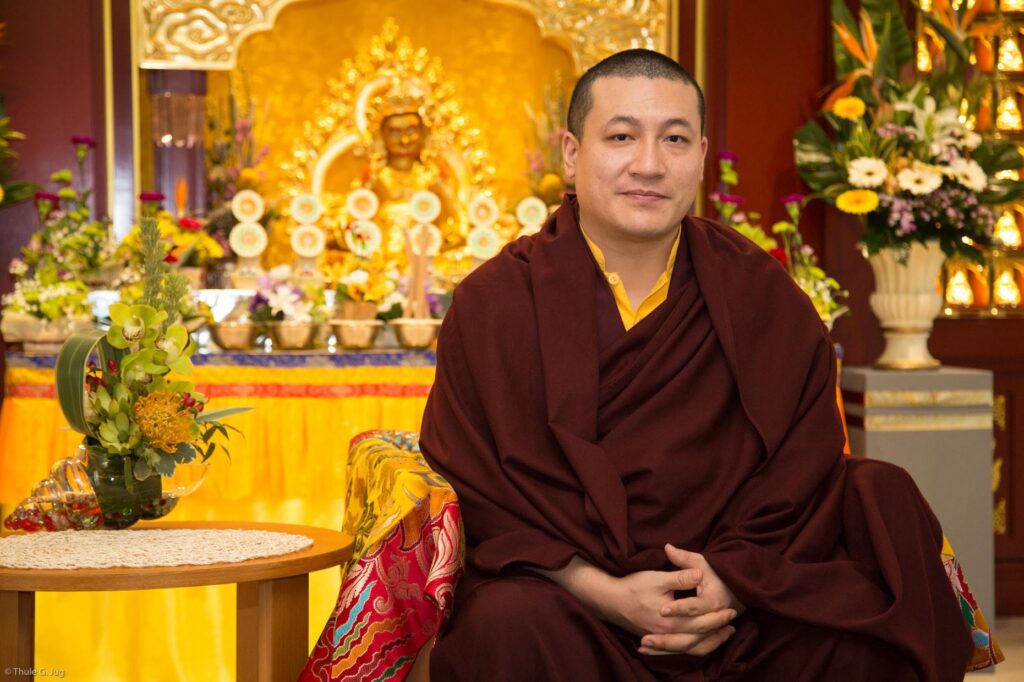
在佛教的義理來看,我們社會中的所有問題都是源於缺乏了解,對於未知的恐懼。當我們通透過邏輯、推理,利用我們內在無窮盡的智慧和慈悲心來克服這種無知時,我們不僅會對自己,還有對我們的世界展現出希望。
噶瑪巴
In Buddhist terms, all of the problems in our society stem from a lack of understanding, a fear of the unknown. When we challenge this ignorance through logic, through reasoning, through tapping into our boundless internal resources of wisdom and compassion, we manifest hope – not just for ourselves, but for our world.
Karmapa
——-
在某程度上,成熟能承擔責任是很重要,但也有其做得太過的風險。當我們這樣做時,我們最終走上極端,要麼就是努力試圖在我們的經驗中尋找美好的特質,要麼就是以單方面的消極方式來尋找缺點。簡而言之,我們成為讚美和批評的受害者。
事實上,讚美和批評既不是正面也不是負面。它們實際上只是能量的另一種形式。它們只是世俗習慣。行菩薩道的,是不會拒絕這些,拒絕就像否定生命本身,反之我們是要用善巧方法利用它們,就像使用適量的鹽或糖一樣。
噶瑪巴
To a certain degree, it is important to mature and take responsibility, but there is a risk of going too far. When we do this, we end up relating to our experiences through their extremes – either forcefully trying to find positive qualities in our experiences, or finding faults in a one-sidedly negative way. In short, we become victims of praise and criticism.
In fact, praise and criticism are neither positive nor negative. They are, in fact, just another form of energy. They are everyday rituals and practices. The way of the Bodhisattva is not to reject these things – this would be like rejecting life itself – but to find skilful means to use them in moderation, like using a pinch of salt or sugar.
Karmapa
(Photo/Thule)
(中文翻譯由本中心翻譯小組負責。若有錯漏,請見諒。節錄或載列文章內容以原文為準。)
噶瑪巴 對 黎巴嫩和印度發生的悲劇 發出的訊息
9 August 2020
噶瑪巴對黎巴嫩和印度發生的悲劇發出的訊息。
親愛的佛友
你們當中許多人必定再次對最近所發生的悲劇感到震驚。
本週發生在貝魯特的大規模爆炸奪去了許多人的生命,並傷害了數千人;昨天在喀拉拉邦發生的飛機失事,至少有18人喪生,這顯然是令人難過的事情。
當我們正在經歷全球大疫情之同時,也發生這樣的悲劇,即使我們想為這些事情幫上一些忙,然而這些悲劇卻使我們的心不勝負苛,讓我們感到無助。
這些慘劇會令我們感到困惑,“為什麼這些悲劇反覆發生?” 沒有人覺得是自己造成這些障礙,因為我們天生就是善良和純潔的。那麼為什麼這些事情會發生?為什麼我會有這些感覺?人類為什麼要經歷這種苦難?我只能說,我們有這種感覺是很正常的,有這種情緒是完全正常的。
但是,如果我們只是停滞於這種情感推理和質疑,那麼我們就會迷失於此,並且感覺好像沒有出路。
因此,即使我們大多數人不認識那些死傷和受影響的人,但是因為我們彼此擁有人身這個共通處,它有助於我們彼此聯繫,最重要的是,它使我們能夠將情感推理和問題釋放,並轉化為有意義的東西。
首先,要專注我們彼此共同之處,縱使我們跟他們互不相識,我們也會給予他們同情。
我們可以為亡者祈禱,使他們找到他們一直渴望的和平與幸福。僅僅因為他們已經去世而不存在,並不代表他們失去了他們所追求的目標,即和平與幸福。他們將通過我們實現他們的渴望。
就是這樣,通過我們這些陌生人。你可以看到,他們也不認識我們。但是由於我們有著相似之處,例如希望和恐懼,他們的去世迴盪在我們心中,因此他們的夢想沒有失去。透過我們的願望,我們將為他們實現他們的夢想。因此,實際上我們可以對這些悲劇和其他所有悲劇作出貢獻。
我們作為初學佛法的佛教徒,應為死者祈禱,使他們的願望得以實現。
我不知道這是否有幫助,但是當有人要求他人為某人的往生祈禱時,我總是將之視為,是往生者讓在世的人可以活著善良和具道德的人生,這樣,亡者就可以透過在世的人獲得功德。
致上慈悲
第十七世大寶法王嘉華噶瑪巴泰耶多傑
Karmapa’s message following tragedies in Lebanon and India.
Dear dharma friends
Many of you must once again be taken aback by the recent tragedies.
The news of the massive explosion in Beirut this week, which claimed many lives and harmed thousands, and yesterday’s plane crash in Kerala, in which at least 18 people lost their lives, are obviously sad things to reflect upon.
When tragedies of such a kind unfold – on top of the global pandemic that we are all experiencing – they burden our hearts by making us feel helpless, even though we want to do something about them.
They confuse us by giving rise to the feeling ‘why do these tragedies occur repeatedly?’ None of us feel that we caused these obstacles, as we have an innate sense of being kind and pure. So why does it have to happen? Why am I feeling this way? Why do people have to experience such pain? All I can say is that it is perfectly normal for us to feel that way. It’s perfectly normal to feel such emotions.
But if we just hang on to this emotional reasoning and questioning then we will become lost in the emotional reasoning and questioning, and it will feel as though there is no way out.
So even though most of us don’t know those who have lost their lives or those who are affected, nevertheless utilising the similarities we share as human beings will help us to connect with one another and, most importantly, it enables us to let the emotional reasonings and questions flow out and transform into something meaningful.
To begin with, by focusing on the similarities we share, we can sympathise with them without having to know them intimately.
We can aspire for the deceased ones in such a way that they find the peace and happiness that they were always yearning for. Just because they have passed away from this existence does not mean that they lost what they strived for: their peace and happiness. They will achieve what they yearned for – through us.
Yes, through this lot of strangers, us. You see, they didn’t know us either. But because of the similarities we share, such as hopes and fears, their passing echoes in us, and therefore their dreams are not lost. Through our aspirations, their dreams will be realised by us for them. So, in fact, we can do something about these and all other tragedies.
We, as beginner Buddhist practitioners, offer our prayers for the deceased so that their aspirations will be realised.
I don’t know if this helps but when someone asks another to pray for someone’s passing, I always view that as the deceased’s way of making the living live a virtuous life. In that way the deceased ones earn merit through the living.
With compassion
Thaye Dorje
His Holiness the 17th Gyalwa Karmapa
Source: https://www.karmapa.org/karmapas-message-following-tragedies-in-lebanon-and-india/
#Karmapa
(Photo/Tokpa Korlo)
(中文翻譯由本中心翻譯小組負責。若有錯漏,請見諒。節錄或載列文章內容以原文為準。)
8月11日星期二 大寶法王之子Thugseyla 的兩歲生日
各位師兄,
8月11日星期二是大寶法王之子Thugseyla 的兩歲生日。當天下午1:30 洽美仁波切及Umzela 會主持誦經祈福及由兩位董事代表獻哈達,祝Thugseyla 身體健康、快樂長壽、菩提精進!
由於疫情關係,恕不對外開放。師兄們可以作以下的祈福:
(1)心意卡:向Thugseyla 寫上祝福語(費用全免)
由今天開始至8月11日中午12:30止。請把「祝福語」個別傳送到中心手機 (+852) 5507 1138,職員會代為填寫。
(2)隨喜供花、供果品
(3)供燈 :3日燈每盞$2007日燈每盞$300
請入數中心戶口:New Horizon Buddhist Association Ltd
匯豐銀行 601-024367-001
報名的師兄請私下聯絡中心職員,以便安排。謝謝
♀️




